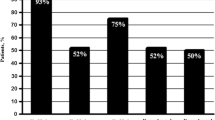Abstract
Purpose
This study investigated the utility of retrospective two one-sided cumulative sum (CUSUM) charts combined with multivariable regression analysis in liver transplantation for transplant center benchmarking.
Methods
One thousand seven hundred and forty-nine consecutive adult primary liver transplants (January 1, 1983 to December 31, 2012) were analyzed retrospectively with two one-sided CUSUM chart analysis of 90-day mortality.
Results
Three eras and two subseries in latest era 3 were identified due to graphically delineated relevant shifts in mean 90-day mortality. Delineation of eras 1, 2, and 3 coincided with relevant changes in allocation policies. CUSUM analysis detected a resurgence of higher mean 90-day mortality in era 3 after results had improved continuously over 25 years. In era 3, two subseries were identified with improving mean 90-day mortality rates from 15.4% in subseries 1 to 8.9% in the following subseries 2. The quantitative influence of independent risk factors on 90-day mortality differed markedly between all identified eras and subseries as assessed with multivariable regression analysis deployed on era-specific subcohorts.
Conclusion
The assessed methodology is able to identify meaningful center-specific eras and subseries of liver transplantation with striking alterations of the significance and weight of outcome drivers for post-transplant 90-day mortality over time. This warrants the introduction of prospective risk-adjusted two one-sided CUSUM chart analysis into quality management in liver transplantation in Germany with the goal to obtain alarm signals as early as possible.



Similar content being viewed by others
References
Schrem H, Kaltenborn A (2013) Germany: avoid more organ transplant scandals. Nature 498:37
Seehofer D, Schöning W, Neuhaus P (2013) Deceased donor liver transplantation [article in German]. Chirurg 84:391–397
Metz C, Hoppe N (2013) Organ transplantation in Germany: regulation scandals and scandalous regulation. European Journal of Health Law 20:1–4
Axelrod D, Guidinger M, Metzger R, Wiesner R, Webb R, Merion R (2006) Transplant center quality assessment using a continuously updatable, risk-adjusted technique (CUSUM). Am J Transplant 6:313–323
Axelrod DA, Kalbfleisch JD, Sun RJ, Guidinger MK, Biswas P, Levine GN et al (2009) Innovations in the assessment of transplant center performance: implications for quality improvement. Am J Transplant 9:959–969
Neuberger J, Madden S, Collett D (2010) Review of methods for measuring and comparing center performance after organ transplantation. Liver Transpl 16:1119–1128
Montgomery DC (2012) Time-weighted control charts. In: Montgomery DC Statistical quality control: a modern introduction, 7th edn., Wiley, New York, pp 414–431
Hosmer DW, Lemeshow S, Sturdivant R (2013) Applied logistic regression, Third edn. John Wiley & Sons, Inc, New Jersey, pp 89–94
Bundesärztekammer (2000) Richtlinien zur Organtransplantation gemäß § 16 Transplantationsgesetz. DtschArztebl 97: A-396 / B-333 / C-310
Bundesärztekammer (2006) Richtlinien zur Organtransplantation gemäß § 16 TPG. DtschArztebl 103: A-3282 / B-2858 / C-2738
Sood A, Ghani KR, Ahlawat R, Modi P, Abaza R, Jeong W et al (2014) Application of the statistical process control method for prospective patient safety monitoring during the learning phase: robotic kidney transplantation with regional hypothermia (IDEAL phase 2a-b). Eur Urol S0302-2838:00184–00185
Li J, Lo A, Hon S, Ng S, Lee J, Leung K (2012) Institutional learning curve of laparoscopic colectomy—a multi-dimensional analysis. Int J Color Dis 27:527–533
Maguire T, Mayne C, Terry T, Tincello D (2013) Analysis of the surgical learning curve using the cumulative sum (CUSUM) method. Neurourol Urodyn 32:964–967
Bartlett A, Parry B (2001) Cusum analysis of trends in operative selection and conversion rates for laparoscopic cholecystectomy. ANZ J Surg 71:453–456
Steiner SH, Cook RJ, Farewell VT, Treasure T (2000) Monitoring surgical performance using risk-adjusted cumulative sum charts. Biostatistics 1:441–452
Weismüller TJ, Negm A, Becker T, Barg-Hock H, Klempnauer J, Manns MP, Strassburg CP (2009) The introduction of MELD-based organ allocation impacts 3-month survival after liver transplantation by influencing pretransplant patient characteristics. Transpl Int 22(10):970–978
Bahra M, Neuhaus P (2011) Liver transplantation in the high MELD era: a fair chance for everyone? Langenbeck's Arch Surg 396(4):461–465. doi:10.1007/s00423-011-0766-y
Weismüller TJ, Fikatas P, Schmidt J, Barreiros AP, Otto G, Beckebaum S, Paul A, Scherer MN, Schmidt HH, Schlitt HJ, Neuhaus P, Klempnauer J, Pratschke J, Manns MP, Strassburg CP (2011) Multicentric evaluation of model for end-stage liver disease-based allocation and survival after liver transplantation in Germany—limitations of the ‘sickest first’-concept. Transpl Int 24(1):91–99
Petrowsky H, Rana A, Kaldas FM, Sharma A, Hong JC, Hong JC, Agopian VG et al (2014) Liver transplantation in highest acuity recipients: identifying factors to avoid futility. Ann Surg 259:1186–1194
Schrem H, Focken M, Gunson B, Reichert B, Mirza D, Kreipe HH et al (2016) The new liver allocation score for transplantation is validated and improved transplant survival benefit in Germany but not in the United Kingdom. Liver Transpl 22(6):743–756
Reichert B, Kaltenborn A, Goldis A, Schrem H (2013) Prognostic limitations of the Eurotransplant-Donor Risk Index in liver transplantation. J Negat Results Biomed 24:12–18
Author information
Authors and Affiliations
Contributions
Study conception and design: Harald Schrem, Sophia Volz, Hans-Friedrich Koch, Priscila Kürsch, and Alexander Kaltenborn. Acquisition of data: Harald Schrem, Sophia Volz, Priscila Kürsch, and Alexander Kaltenborn. Analysis and interpretation of data: Harald Schrem, Sophia Volz, Hans-Friedrich Koch, Jill Gwiasda, Priscila Kürsch, Alon Goldis, Jürgen Klempnauer, and Alexander Kaltenborn. Drafting of manuscript: Harald Schrem, Sophia Volz, Jill Gwiasda, and Alexander Kaltenborn. Critical revision of manuscript: Harald Schrem, Sophia Volz, Jill Gwiasda, Hans-Friedrich Koch, Priscila Kürsch, Alon Goldis, Daniel Pöhnert, Markus Winny, Jürgen Klempnauer, and Alexander Kaltenborn.
Corresponding author
Ethics declarations
Funding
This study was funded by a grant from the German Federal Ministry of Education and Research (reference number: 01EO1302).
Conflict of interest
The authors declare that they have no conflict of interest.
Ethical approval
This article does not contain any studies with animal or human participants performed by any of the authors.
Informed consent
Informed consent was obtained from all individual participants included in the study.
Rights and permissions
About this article
Cite this article
Schrem, H., Volz, S., Koch, HF. et al. Statistical approach to quality assessment in liver transplantation. Langenbecks Arch Surg 403, 61–71 (2018). https://doi.org/10.1007/s00423-017-1612-7
Received:
Accepted:
Published:
Issue Date:
DOI: https://doi.org/10.1007/s00423-017-1612-7




